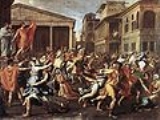
Military history of ancient Rome
Overview
From its origin as a city-state in Italy
in the 8th century BC, to its rise as an empire
covering much of Southern Europe
, Western Europe
, Near East
and North Africa
and fall in the 5th century AD, the political history of Ancient Rome
was typically closely entwined with its military history
. The core of the campaign history of the Roman military is an aggregate of different accounts of the Roman military's land battles, from its initial defence against and subsequent conquest of the city's hilltop neighbours in the Italian peninsula
, to the ultimate struggle of the Western Roman Empire
for its existence against invading Huns, Vandals
and Germanic tribes
after the empire's split into East and West
.
History of Italy during Roman times
This is an overview of the history of Italy during Roman times.According to legend, Rome was founded in 753 BC by Romulus and Remus, and was then governed by seven Kings of Rome...
in the 8th century BC, to its rise as an empire
Roman Empire
The Roman Empire was the post-Republican period of the ancient Roman civilization, characterised by an autocratic form of government and large territorial holdings in Europe and around the Mediterranean....
covering much of Southern Europe
Southern Europe
The term Southern Europe, at its most general definition, is used to mean "all countries in the south of Europe". However, the concept, at different times, has had different meanings, providing additional political, linguistic and cultural context to the definition in addition to the typical...
, Western Europe
Western Europe
Western Europe is a loose term for the collection of countries in the western most region of the European continents, though this definition is context-dependent and carries cultural and political connotations. One definition describes Western Europe as a geographic entity—the region lying in the...
, Near East
Near East
The Near East is a geographical term that covers different countries for geographers, archeologists, and historians, on the one hand, and for political scientists, economists, and journalists, on the other...
and North Africa
North Africa
North Africa or Northern Africa is the northernmost region of the African continent, linked by the Sahara to Sub-Saharan Africa. Geopolitically, the United Nations definition of Northern Africa includes eight countries or territories; Algeria, Egypt, Libya, Morocco, South Sudan, Sudan, Tunisia, and...
and fall in the 5th century AD, the political history of Ancient Rome
Ancient Rome
Ancient Rome was a thriving civilization that grew on the Italian Peninsula as early as the 8th century BC. Located along the Mediterranean Sea and centered on the city of Rome, it expanded to one of the largest empires in the ancient world....
was typically closely entwined with its military history
Military history
Military history is a humanities discipline within the scope of general historical recording of armed conflict in the history of humanity, and its impact on the societies, their cultures, economies and changing intra and international relationships....
. The core of the campaign history of the Roman military is an aggregate of different accounts of the Roman military's land battles, from its initial defence against and subsequent conquest of the city's hilltop neighbours in the Italian peninsula
Italian Peninsula
The Italian Peninsula or Apennine Peninsula is one of the three large peninsulas of Southern Europe , spanning from the Po Valley in the north to the central Mediterranean Sea in the south. The peninsula's shape gives it the nickname Lo Stivale...
, to the ultimate struggle of the Western Roman Empire
Western Roman Empire
The Western Roman Empire was the western half of the Roman Empire after its division by Diocletian in 285; the other half of the Roman Empire was the Eastern Roman Empire, commonly referred to today as the Byzantine Empire....
for its existence against invading Huns, Vandals
Vandals
The Vandals were an East Germanic tribe that entered the late Roman Empire during the 5th century. The Vandals under king Genseric entered Africa in 429 and by 439 established a kingdom which included the Roman Africa province, besides the islands of Sicily, Corsica, Sardinia and the Balearics....
and Germanic tribes
Germanic Wars
The Germanic Wars is a name given to a series of wars between the Romans and various Germanic tribes between 113 BCE and 439 CE. The nature of these wars varied through time between Roman conquest, Germanic uprisings and later Germanic invasions in the Roman Empire that started in the late 2nd...
after the empire's split into East and West
Western Roman Empire
The Western Roman Empire was the western half of the Roman Empire after its division by Diocletian in 285; the other half of the Roman Empire was the Eastern Roman Empire, commonly referred to today as the Byzantine Empire....
.

